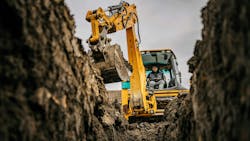How Grease Affects Ownership Costs
Key Highlights
- How the right grease prevents equipment wear and reduces maintenance costs.
- How high-performance greases improve equipment uptime.
- How grease technologies can offer longer service intervals.
- How integrating grease selection into PM programs enhances fleet longevity.
In construction, where uptime is money and equipment failures derail projects, lubrication is often treated as an afterthought—particularly grease. It’s understandable. Grease is a relatively low-cost item, purchased in smaller quantities compared to fuel or oil. But that underestimation can come at a steep price.
Across construction sites, lubrication decisions play an outsized role in long-term performance, repair frequency, and maintenance budgets. The choice of grease—its quality, consistency, and suitability for each application—can determine whether machines run smoothly for years or require costly service far too soon.
The hidden cost isn’t in the grease itself. It’s what happens when you choose the wrong one. Grease might only cost a few dollars per pound, but it protects components that can cost tens of thousands to replace. From swing bearings to loader pins, many critical parts rely on grease to manage shock loads, resist contamination, and perform under constant vibration and pressure.
More maintenance management
- Why you should integrate telematics into your PM program.
- A smart approach to repair and maintenance.
- Tackle fluid contamination.
- Asset management in an inflationary environment.
- Fluid analysis data cuts downtime.
- Non-CDL service equipment elevates field maintenance.
With countless formulations available, selecting the right grease can seem complex, leading some fleets to oversimplify the decision. The temptation to consolidate to a single product across all applications may appear efficient, but this approach frequently introduces hidden compromises in performance, as different applications have different requirements.
For example, a grease that excels at high load-carrying capacity may perform poorly in high-speed bearings or in extreme temperatures. A mismatch leads to subpar protection, increased wear, and more frequent re-greasing or part replacements.
Why grease quality is important
The quality of the grease used plays a critical role in equipment health. High-performance greases are engineered to provide lasting protection under extreme operating conditions. They resist washout, maintain structural integrity over longer intervals, and perform consistently across temperature swings and high pressures.
When grease quality is inconsistent or suboptimal, problems can cascade quickly. For example, poor pumpability in cold weather or variable viscosity across batches can hinder proper distribution, leading to under-lubrication. In automated systems, this can mean blocked lines and unprotected components, ultimately causing avoidable equipment failures.
In contrast, using a reliable, well-formulated grease helps ensure consistent protection. Fewer surprises mean fewer reactive maintenance interventions and a more stable maintenance schedule.
How grease can reduce total cost of ownership
Although premium greases cost more upfront, they often reduce total cost of ownership through:
- Lower grease consumption: Greases that stay in place longer reduce reapplication frequency, sometimes cutting usage by 25–35%.
- Fewer component replacements: Proper lubrication reduces wear, helping bearings and other parts reach their full service life.
- Increased uptime: Better lubrication translates to fewer breakdowns, more productive machine hours, and reduced emergency repairs.
To track ROI on a premium grease, fleet managers can monitor key performance indicators (KPIs) such as average time between greasing, bearing life, lubricant consumption, and unscheduled maintenance. Over time, improved lubrication should show measurable gains in equipment availability and reduced maintenance costs.
Integrate grease selection into PM programs
Preventive maintenance programs are only as effective as the products that support them. Grease selection plays a foundational role in enabling longer service intervals and achieving asset life goals. By aligning lubrication decisions with desired performance outcomes, such as hitting a specific bearing life target or extending the time between rebuilds, fleets can better plan, predict, and control costs.
Relying on “just good enough” products may seem cost-effective in the short term, but the long-term effects are rarely worth the trade-off. Proactive grease selection, tied to defined maintenance objectives, supports fleet longevity and allows managers to move away from reactive maintenance models.
Several myths can undermine lubrication strategy. Among the most common:
- “Grease is grease.” Not all products are created equal. Using a grease that merely meets the minimum specs can leave equipment vulnerable to wear and premature failure.
- “One grease fits all.” Attempting to consolidate to a single product may lead to compromises that affect protection across multiple applications.
- “The color tells you everything.” Although some believe red means high-temp or green means eco-friendly, color is not a reliable indicator of performance. Grease selection should be based on formulation, not appearance.
Grease technologies
Today’s advanced greases leverage innovations in thickeners and additive technologies to deliver greater performance under severe operating conditions. For instance, calcium sulfonate complex greases offer superior resistance to water washout and provide better sealing in older equipment where leakage is a concern. They also offer improved performance in high-load and shock-load conditions, common in construction sites.
Compared to older, cost-optimized greases that merely meet minimum specs, modern high-performance formulations contribute to lower maintenance frequency, longer equipment life, and fewer environmental impacts due to reduced consumption and waste.
Key principles in grease selection
When it comes to grease selection in the construction sector, a few key principles can make a significant difference:
- Tailor grease choices to equipment needs: Don’t default to a one-size-fits-all approach.
- Invest in long-life, high-performance greases: They reduce both operating costs and environmental impact by minimizing waste and maximizing protection.
- Use lubrication strategy as a lever for uptime and sustainability: Good grease supports not only cost control but also long-term asset stewardship.
Ultimately, taking shortcuts on grease might seem like a cost-saving move, but it’s often the opposite. Grease is more than a commodity. It’s a strategic component of fleet reliability, and equipment teams that prioritize lubrication quality stand to gain the most, through reduced downtime, longer equipment life, and more efficient operations.
About the Author
Anoop Kumar
Anoop Kumar is senior staff scientist at Chevron.

